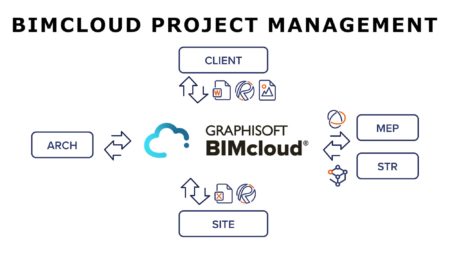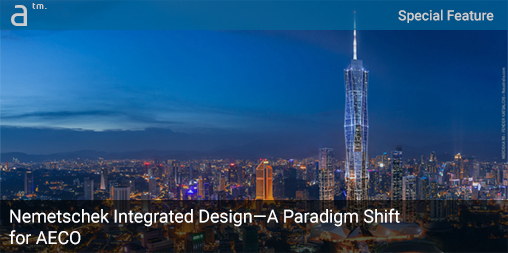WHILE BIM HAS ADVANCED GREATLY over the years, Nemetschek’s customers have been asking for the next step in BIM industry evolution. That step is about breaking free from—or at least expanding upon—the traditional “federated model” approach. In the new “integrated design” approach architects and their consultants work together on a single BIM model, a single set of data, working in a shared work environment using best-of-breed tools respective of AECO industry disciplines.
A Lack of Progress
Fundamentally, the way architects and structural engineers work together hasn’t really changed much over the past two or three decades.
The architect creates a design and sends the engineer her design as a context over which to work. The structural engineer either gets 2D plans and sections the architect chose to create and send or in the world of federated BIM workflows, the architect sends a BIM model. When the architect makes changes, she sends a new version of the BIM model as an update, often at weekly intervals during the design development stage. The structural engineer provides his part of the design—loadbearing structures—back to the architect in a similar workflow.
At the heart of the issue is that the project team focuses a lot on clash detection after the fact of creating these models rather than on doing quality checks in real-time with new types of real-time solutions.
In both the pre-BIM era and today’s BIM era, the structural engineer and architect are entered into a dance of asynchronous data exchange. One party is always waiting for the other for information. But work cannot stop for long, so each discipline furthers their part of the design and gets work done simultaneously, often using—and ideally so—their preferred software tools.
As the architect works with both the structural engineer and the MEP consultants in this way, the apparent industry answer is to federate BIM models from everyone, through imports and exports, and then examine the whole for “clash detection”—finding objects that are running into other objects, like beams going through air ducts.
The whole process is suboptimal in the eyes of Nemetschek, which this July introduced “Integrated Design,” a multi-brand solution involving Archicad, SCIA Engineer, RISA 3D, and FRILO.
Viktor Várkonyi, Chief Division Office, Planning & Design Division, spoke to me at length a few weeks ago after the GRAPHISOFT Building Together virtual conference.
“At the heart of the issue is that the project team focuses a lot on clash detection after the fact of creating these models,” he says, “rather than on doing quality checks in real-time with new types of real-time solutions.”
Towards Synchronous Design
Várkonyi says that the Nemetschek Group is challenging the existing paradigm in AECO of “siloed design teams” by introducing technologies similar to how the software industry has evolved, enabling “agile design teams.” Instead of a slow and error-prone sequential process with lots of handovers, they propose synchronous workflows involving architects and engineers; instead of clash detection and fixing post-action, they propose clash avoidance in the first place; instead of the coordination of designs, they propose designing together as one team.

Merdeka 118 by Fender Katsalidis Architects, Melbourne, Australia, will be the world’s second-tallest skyscraper once completed next year and was designed completely in Archicad. It is the signature project for the release of Archicad 24. (Image: Merdeka 118 – Fender Katsalidis | fkaustralia.com. All rights reserved.)
In order for this vision to come to life, the Nemetschek Group has advanced a new “parameter-level” control and vision of how BIM solutions can talk to each other. In a nutshell, what they have done is introduce an “analytical model” inside of Archicad 24 that is a native part of common BIM elements like columns, slabs, roofs, walls, and beams. This analytical model is the basis for communication bi-directionally with structural engineering analysis software solutions like SCIA Engineer and RISA 3D and FRILO.
In the Nemetschek vision, the structural engineer and the architect both use Archicad for designing the core structure of the building. On the engineer’s side, Archicad 24’s analytical model has bi-directional linkages to either of those Nemetschek brand engineering solutions just mentioned.
The beauty of our solution is that the more you communicate with each other the more efficient the whole process is.
With these solutions now connected, the architect and engineer can operate simultaneously in real-time while knowing what the other party changes nearly simultaneously via BIMcloud as the globally available cloud infrastructure connecting the team. There is no need to exchange BIM models at the end of the week for coordination; changes such as make a column section larger, for example, or extend a beam further, or rearrange its position are available to the relevant stakeholders in real-time.
A New Standard—SAF
This new bi-directional analytical model is made possible thanks to a brand new open-source format—SAF (Structural Analysis Format)—developed by the Nemetschek Group. In addition, IFC’s SAV (Structural Analysis View) format can also be used to communicate with third-party solutions.
Várkonyi said that the SAF file format is Excel-based which is really exciting to the engineers who like control but need a format that an average human can read. “It is not a certified format yet, but we keep developing it as an open-source project,” he adds.

The structural analysis model (SAM) carries data with it (via SAF) that enables bi-directional linkages between engineering analysis tools and Archicad. SAF is an open-source project and third-party structural analysis tools outside of the Nemetschek Group have begun embracing it.
Várkonyi says that in the Group’s view, IFC is a general-purpose format and the industry needs laser targeted formats such as SAF for specialized focused purposes like this relationship between architect and structural engineer and the connection between analytical models and BIM models. “IFC just offers too much,” he says, “SAF was really developed around the needs of the engineers,” who he says are conservative and like to have control.
SAF is gaining popularity and he says that all the major players in Europe are already supporting it or will soon be. “We also had some initial steps in the US with Etabs,” he adds.
BIMcloud and Nemetschek
Várkonyi adds that it’s not just that they added an analytical model to Archicad 24. “It’s the whole process around it,” he says, “the BIM tracking, the model change tracking, notifications, subscribing to various parameters, and if that parameter changes you get a notification. So I consider this management layer much more important than the technology itself,” he says.

BIMcloud Project Management where data flows between the architect, client, consultant engineers, and the building site. Each party can view data inside BIMcloud—BIM models in native Archicad formats, IFC, data in Excel and PDF formats, and other formats as well.
This entire stack of management and technology works through GRAPHISOFT’s BIMcloud, which is becoming a critical hub in the cloud for the Nemetschek Group. BIMcloud is already the most capable and performant BIM server in the industry, but its latest updates make it a type of “connected data environment” or CDE. That latter term is commonly associated with “common data environments” but Várkonyi emphasizes that commonality is losing out in the industry to connectedness.
“In the past few years, the AEC industry has started to challenge this notion of one CDE tool being able to address all needs,” he says. “Major stakeholders still use their own data environment that is special for their given purposes or what is serving the processes of that given company.”
Architosh has previously discussed the Nemetschek Group’s view on an API-connected future of CDEs. Várkonyi says that the industry needs to get these systems “connected” instead of going for one which is not optimal for any stakeholder or AEC participant.
Nemetschek Integrated Design
This new Integrated Design strategy with four of the company’s brands is just the early stages of advancing the industry towards more synchronous workflows and agile design teams.
“The beauty of our solution is that the more you communicate with each other the more efficient the whole process is,” he says. “So it is really changing the behavior; people want to share data, they want to involve others.”

A view of Archicad 24 and its new structural analytical model features with parameter-level controls over structural building structure elements like columns, beams, etc.
“When we approached companies about this vision years ago they got very excited,” he says, because they feel the pain of working in silos.” He says what their customers have been reporting is that the current federated processes are putting a penalty on the overhead of communicating with the other parties. “It is extra work to prepare your [model] data, to send your data, to receive and reply to consultants,” he says.
In the past few years, the AEC industry has started to challenge this notion of one CDE tool being able to address all needs. Major stakeholders still use their own data environment that is special for their given purposes or what is serving the processes of that given company.
Nemetschek Integrated Design aims to solve a lot of these pain points. The new SAF open standard and discussions across the industry are paving the way for an alternative process that will bring streamlining to the entire AECO industry. Will this happen overnight? Várkonyi knows better as a three-decade veteran of the AEC industry; movement in this industry can be slow but when new methods do bring concrete results in time savings and better design, change can happen much faster. One only needs to look at the boom in construction tech tools like Procore, for example, which has swept up the US contractors market, or before that Bluebeam, which did the same.
The pain points between architects and their consultants are real. Nemetschek’s latest innovation seems laser-focused on handling the relationship between architect and structural engineer, one he hopes ripples through the global industry, springboarding from some of the biggest digital tools in the largest AEC markets. “We can solve big industry problems with the leadership of a few brands,” he concludes.
Image Credits
Format equates to “party with copyright” / “party with reserved rights of use.” (eg: image: Itten+Brechbühl / Architosh. All rights reserved.) Not credited images are copyrighted to Architosh.
Title Credit: ( Image: Merdeka 118 by Fender Katsalidis, Melbourne, Australia / Architosh. All rights reserved.)




Reader Comments
Comments for this story are closed